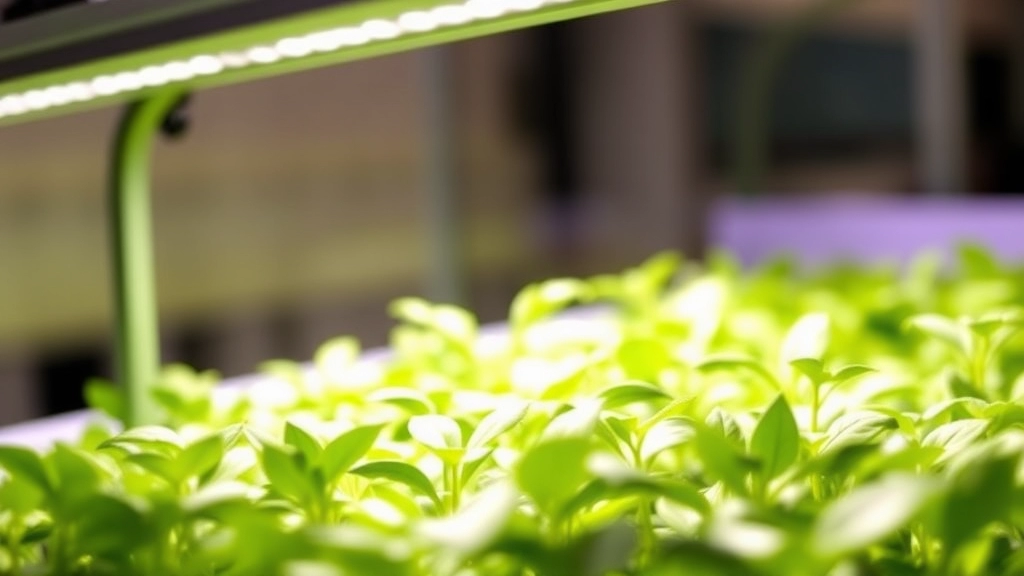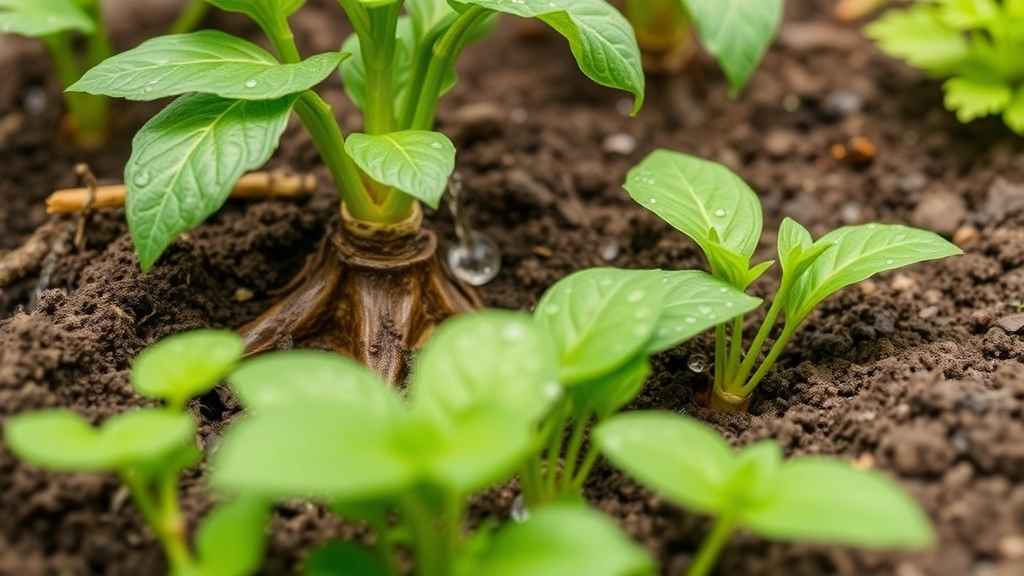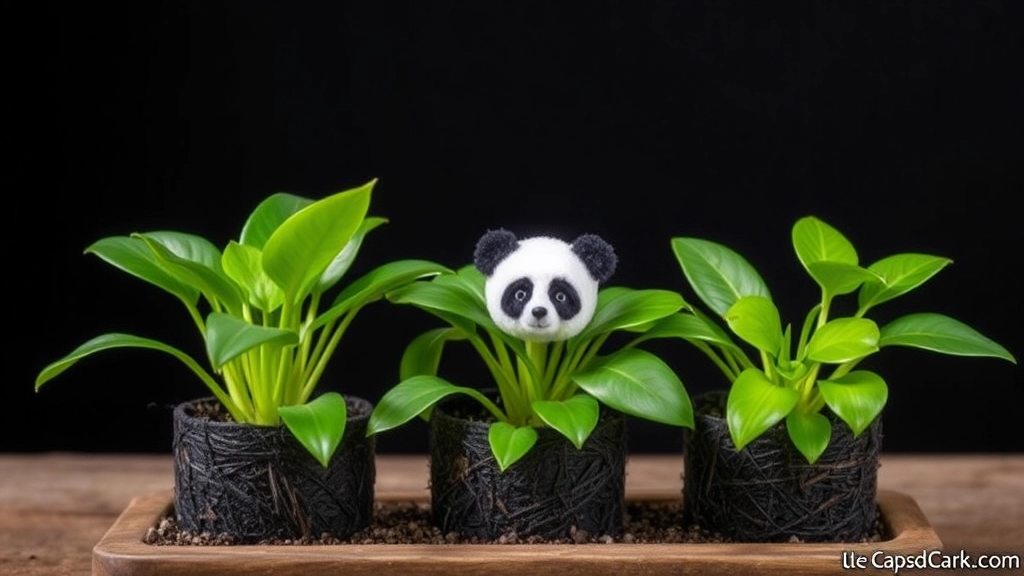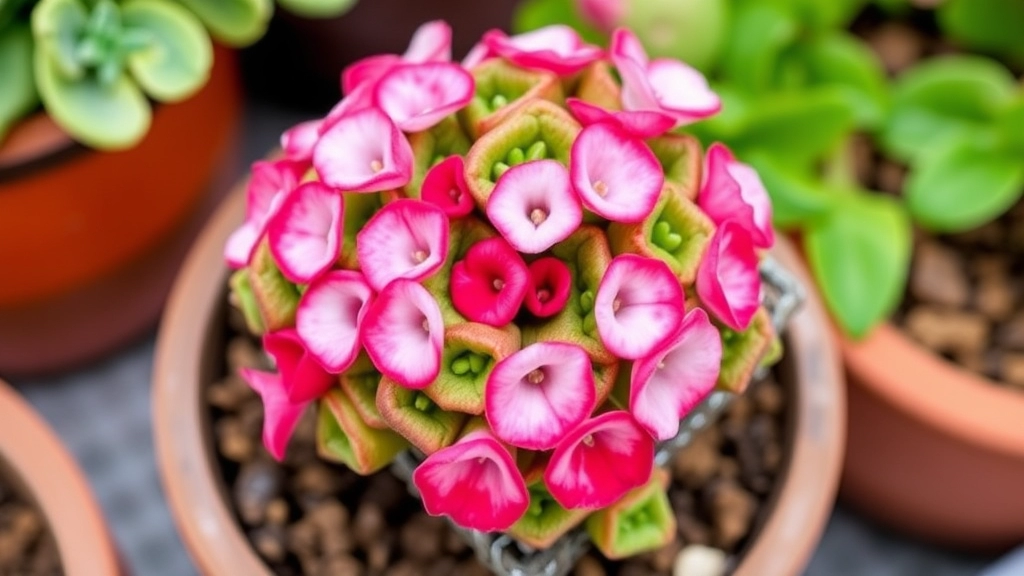Kalanchoe Panda Plant Guide
The Kalanchoe Panda Plant, also known as Kalanchoe tomentosa, is a favourite among houseplant enthusiasts for its fuzzy leaves and easy care. If you’re looking to add this charming succulent to your collection, you’ve come to the right place. In this guide, I’ll walk you through everything you need to know about identifying, growing, and maintaining a healthy Kalanchoe Panda Plant.
Essential Care Information
From understanding its light and temperature needs to mastering proper watering techniques, this article covers all the essentials. You’ll also find tips on:
- The best soil and potting mix
- How to fertilize during growing seasons
- Methods for propagating new plants from cuttings
Pest and Disease Management
Plus, I’ll share advice on dealing with common pests and diseases, ensuring your Panda Plant thrives for years to come.
How to Identify Kalanchoe Panda Plant
Are you struggling to identify the charming Kalanchoe Panda Plant in a sea of succulents?
This delightful plant, also known as Kalanchoe tomentosa, is recognised for its unique features that make it stand out.
Key Identification Features:
- Leaves: The Panda Plant boasts thick, fuzzy leaves that are a striking green with distinctive brown or reddish edges. These leaves resemble little panda paws, which is where the plant gets its name.
- Height: Typically, this succulent grows to about 30 cm (12 inches) tall, making it an ideal choice for both indoor and outdoor settings.
- Flowers: When in bloom, the Kalanchoe Panda Plant produces tubular yellow or orange flowers, though these may not appear often in indoor conditions.
- Growth Habit: The plant has a bushy appearance, with leaves that grow in pairs along the stems, adding to its aesthetic appeal.
Once you’ve identified these characteristics, you’ll be able to recognise the Kalanchoe Panda Plant with ease. For more detailed care instructions, check out our complete guide to caring for Kalanchoe tomentosa. Additionally, if you’re interested in propagating this lovely succulent, don’t miss our step-by-step propagation guide.
Light and Temperature Requirements for Optimal Growth

So, you’ve got your Kalanchoe Panda Plant, and now you’re wondering what it needs to thrive. One of the biggest factors in keeping your plant happy is getting its light and temperature just right.
Light Requirements
Panda Plants love bright, indirect sunlight. Here’s what you should keep in mind:
- Direct Sunlight: Too much direct sun can scorch those lovely leaves.
- Low Light: If it’s too dim, your plant might stretch out and become leggy.
- Ideal Location: A spot near a window with filtered light works wonders.
Temperature Preferences
Kalanchoe Panda Plants are pretty chill when it comes to temperature, but they do have their sweet spots:
- Ideal Range: They thrive best in temperatures between 20°C to 24°C (68°F to 75°F).
- Cold Sensitivity: Keep them away from drafts or chilly spots. Anything below 10°C (50°F) can stress them out.
- Humidity: These plants prefer a drier environment, so no need to mist them!
When it comes to growing Kalanchoe Panda Plants, choosing the right soil and potting mix is crucial. You might be wondering, “What type of soil is best for my Panda Plant?”
Panda Plants thrive in well-draining soil that mimics their natural arid habitat. Here’s what to keep in mind:
– **Cactus Mix:** A pre-made cactus or succulent potting mix is ideal. These mixes are designed to drain quickly, preventing water from sitting around the roots.
– **DIY Mix:** If you prefer a homemade blend, combine the following:
– 1 part potting soil
– 1 part coarse sand or perlite
– 1 part pumice or gravel
– **pH Levels:** Aim for a soil pH between 6.0 and 7.0. This range supports optimal nutrient absorption.
– **Drainage:** Ensure your pot has drainage holes. This will help excess water escape, reducing the risk of root rot.
Using the right soil and potting mix not only promotes healthy growth but also keeps your Panda Plant thriving for years to come. For more detailed care instructions, check out our [complete guide to caring for Panda Plants](https://planthq.org/how-to-care-for-panda-plant-kalanchoe-tomentosa-a-complete-guide/). Additionally, if you’re interested in exploring other varieties, our [guide to different Kalanchoe species](https://planthq.org/explore-different-kalanchoe-species-for-your-garden/) can be quite helpful.
Proper Watering Techniques to Prevent Root Rot

As we delve into the watering techniques for Kalanchoe Panda Plants, it’s essential to remember that overwatering is one of the primary causes of root rot. This common issue can quickly jeopardise the health of your beloved plant, so let’s explore how to water effectively.
Understanding Watering Needs
Kalanchoe Panda Plants thrive in a semi-arid environment, meaning they prefer to dry out between waterings. Here are some key points to consider:
- Check the Soil: Always check the top inch of the soil. If it feels dry, it’s time to water. If it’s still moist, hold off.
- Watering Frequency: During the growing season (spring and summer), you may need to water every 2-3 weeks. In the dormant winter months, reduce this to once a month.
- Watering Method: When you water, do so thoroughly. Ensure that water drains out of the bottom of the pot. This helps prevent any water from sitting at the roots.
Signs of Overwatering
It’s crucial to be vigilant about the signs of overwatering, which include:
- Yellowing leaves
- Wilting despite wet soil
- A mushy stem or leaves
If you notice any of these signs, immediately adjust your watering schedule.
Tips for Effective Watering
- Use Well-Draining Soil: Combine your watering strategy with a well-draining potting mix to further reduce the risk of root rot.
- Pot Selection: Ensure your pot has drainage holes. This allows excess water to escape, preventing waterlogged conditions.
- Seasonal Adjustments: Be mindful of seasonal changes. In the hotter months, your plant may need more water, while in cooler months, it will require much less.
How to Fertilize Panda Plants During Growing Seasons
Many plant enthusiasts often wonder how to keep their Kalanchoe Panda Plants thriving, especially during the growing season. Fertilizing is a key component in ensuring these unique succulents receive the nutrients they need to flourish.
Understanding Your Panda Plant’s Nutritional Needs
Kalanchoe Panda Plants, like many succulents, benefit from a balanced approach to fertilization. Here’s how to do it effectively:
- Frequency: Fertilize every 4-6 weeks during the growing season, typically from spring to early autumn. This ensures your plant gets the nutrients it needs without overwhelming it.
- Type of Fertilizer: Use a diluted, balanced liquid fertilizer, ideally one formulated for succulents. Look for an NPK ratio of around 10-10-10 or 20-20-20.
- Dilution: Always dilute the fertilizer to half the recommended strength. This helps prevent root burn, which can be detrimental to your Panda Plant.
Application Tips
- Watering First: Make sure to water your Panda Plant before applying fertilizer. This helps the roots absorb nutrients more effectively.
- Even Distribution: Apply the fertilizer evenly around the base of the plant, avoiding direct contact with the leaves. This reduces the risk of leaf burn.
- Post-Fertilization Care: After fertilizing, continue with your regular watering schedule, but avoid overwatering.
Signs of Nutrient Deficiency
Keep an eye out for signs that your Panda Plant may need more nutrients:
- Pale Leaves: If the leaves lose their vibrant colour, it may indicate a lack of nutrients.
- Stunted Growth: A noticeable slowdown in growth can signal that your plant is not receiving enough nourishment.
By following these guidelines, you can ensure your Kalanchoe Panda Plant remains healthy and vibrant throughout the growing season. For more detailed care tips, check out our complete guide on caring for Panda Plants. If you’re interested in exploring other varieties, our article on top Kalanchoe succulent varieties is a great resource.
Propagation Methods: Growing Panda Plants from Cuttings

So, you’ve got a lovely Kalanchoe Panda Plant, and now you’re thinking about multiplying that beauty.
How do you get started with propagation?
Let’s dive into the simplest methods for growing Panda Plants from cuttings.
Why Propagate?
- It’s a cost-effective way to expand your collection.
- You can share the joy with friends or family.
- It’s a fun little project to keep your green thumb busy.
Steps for Propagation:
- Choose Healthy Cuttings:
- Look for plump, healthy leaves.
- Select a stem that’s at least 3-4 inches long.
- Make the Cut:
- Use clean, sharp scissors or a knife.
- Snip just below a leaf node to encourage growth.
- Let it Callous:
- Place the cuttings in a dry spot for a few hours or overnight.
- This helps prevent rot when you stick them in soil.
- Prepare the Soil:
- Use a well-draining potting mix.
- A mix of cactus soil and perlite works wonders.
- Planting the Cuttings:
- Stick the cut end into the soil about an inch deep.
- Water lightly to settle the soil around the cutting.
- Create a Humid Environment:
- Cover with a plastic bag or a clear plastic dome.
- This keeps moisture in while the roots develop.
- Light and Care:
- Place in bright, indirect light.
- Keep the soil lightly moist but not soggy.
- Watch for Roots:
- In a few weeks, you should see new growth.
- Once established, you can treat them like adult Panda Plants.
Pro Tip:
Label your cuttings if you’re trying different varieties. It’s like a little garden experiment!
Propagation can be a rewarding experience, and soon you’ll have a mini jungle of Panda Plants.
Common Pests and Diseases of Panda Plants and How to Treat Them
As you nurture your Kalanchoe panda plant, you might encounter some common pests and diseases that can affect its health. Understanding these issues is essential for maintaining your plant’s vitality.
Tips for Repotting and Maintaining Long-term Health of Kalanchoe Panda Plants
So, you’ve got your Kalanchoe Panda Plant thriving, and now you’re wondering how to keep it that way for the long haul. Repotting is a great opportunity to refresh your plant’s home and ensure it continues to flourish.
FAQs about Kalanchoe Panda Plant
What kind of light does a Kalanchoe Panda Plant need?
Panda Plants love bright, indirect sunlight. Too much direct sun can scorch their leaves, while low light can make them leggy. An ideal spot is near a window with filtered light.
What is the ideal temperature range for a Kalanchoe Panda Plant?
These plants thrive best in temperatures between 20°C to 24°C (68°F to 75°F). They are sensitive to cold and should be kept away from drafts or temperatures below 10°C (50°F).
How often should I water my Kalanchoe Panda Plant?
During the growing season (spring and summer), water every 2-3 weeks. In the dormant winter months, reduce this to once a month. Always check the top inch of the soil; if it feels dry, it’s time to water.
What are the signs of overwatering my Panda Plant?
Signs of overwatering include yellowing leaves, wilting despite wet soil, and a mushy stem or leaves. If you notice these signs, adjust your watering schedule immediately.
How can I propagate my Kalanchoe Panda Plant?
Propagation can be done through cuttings. Choose healthy cuttings, let them callous, and plant them in a well-draining potting mix. Keep the soil lightly moist and place the cuttings in bright, indirect light.
What type of soil is best for Kalanchoe Panda Plants?
Use a well-draining potting mix. A combination of cactus soil and perlite works well to prevent waterlogged conditions that can lead to root rot.
Do Kalanchoe Panda Plants need high humidity?
No, these plants prefer a drier environment and do not require misting. High humidity is not necessary for their growth.
Can I grow Kalanchoe Panda Plants outdoors?
Yes, but only if the outdoor conditions meet their light and temperature requirements. They should be placed in a spot with bright, indirect sunlight and temperatures within the ideal range.
What should I do if my Panda Plant’s leaves are scorched?
Move the plant to a location with filtered light to prevent further damage. Trim any severely scorched leaves to encourage new growth.
Why is my Panda Plant becoming leggy?
Legginess is often due to insufficient light. Move your plant to a brighter location with indirect sunlight to help it regain its compact shape.
References
-
Growing Kalanchoe Panda Plant
-
Kalanchoe Panda Plant Care
-
Kalanchoe Panda Plant Care Tips
